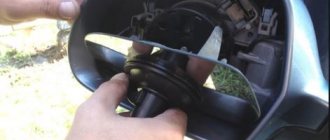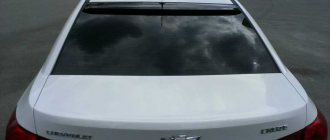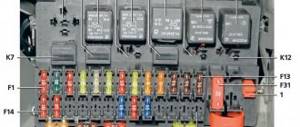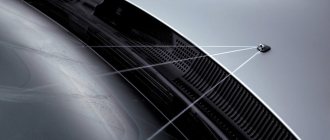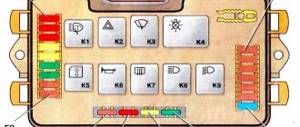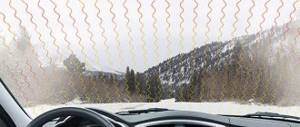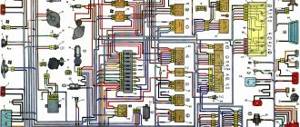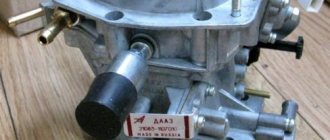Hi all! Today I would like to tell you in more detail about fan-shaped windshield washer nozzles. Such devices are an alternative to classic inkjet devices.
Fans are considered more modern, relevant and effective. Although this point can be debated endlessly. I don't plan to do this yet.
It’s better to tell you about the features of fan nozzles, give recommendations for selection, and also make some clarifications regarding the very pressing issue of adjustment.
What it is
We have already discussed washer nozzles for car windshields. But this time I would like to dwell in more detail on fan devices.
If you have noticed, recently many modern cars have been equipped with new, useful and simply interesting solutions. Even in the basic configurations of inexpensive cars you can find heated seats, a heated rear window, and a number of other devices and solutions.
Among them, it is worth highlighting the fan nozzles on the windshield wiper. Increasingly, they are being installed on cars by automakers.
A distinctive feature of the fan is the method of water supply. If conventional jet devices deliver 2-3 separate jets through special nozzles, then a continuous front of water droplets is created here. This allows you to cover most of the windshield at once. Outwardly, it looks like an open fan. Hence the corresponding name.
And here many people think whether they should buy a similar solution for Renault Logan or Megan, VAZ 2114, Hyundai Solaris, Renault Duster, Kia Rio or any other car. Not everyone understands whether they will be useful and how the behavior of the windshield washer will change after changing the nozzles.
But let's be honest. Toyota, Nissan, Volvo and many other modern foreign cars already have fans installed from the factory. Therefore, there are objective reasons for this. They are obviously better than regular jet sprayers. But even if you have a Priora, Kalina or Chevrolet Niva, no one will forbid you to change the injectors. In addition, there will be no need to make other major modifications to the windshield wiper system.
Advantages and disadvantages
Even in Moscow, driving a car with jet injectors is not a shame. Car owners should consider all the advantages and disadvantages of their decision before making it. After all, there is so much controversy surrounding car mini air conditioners.
Automotive innovations do not always justify financial investments in them.
Therefore, I propose to look at the strengths and weaknesses of fan nozzles. This will allow you to finally decide whether it is worth buying and installing them or not.
Let's start with the positive qualities. These include:
- the washer fluid is supplied more evenly and distributed throughout the glass;
- brushes work more efficiently when passing through wet glass, rather than through dry dust and dirt;
- solid dirt, plaque and stuck insects are better removed;
- the risk of scratching the glass with dry brushes is reduced;
- In some cars, washer fluid consumption is reduced.
Their price is not so high, so the inflated cost certainly cannot be called a disadvantage.
The negative side of fan nozzles includes two main points.
Firstly, due to their design features, such devices are more likely to freeze at subzero temperatures. Therefore, it is better for residents of regions with harsh winters to immediately choose nozzles with a heating system.
Secondly, due to the processing of a large area of the windshield, sometimes the driver loses control over what is happening ahead. That is, the liquid covers the entire glass. Until the brush passes over it, visibility is reduced.
The disadvantages are conditional, but they are worth paying attention to.
Fan windshield washer nozzles: which ones to buy, how to adjust
Hi all! Today I would like to tell you in more detail about fan-shaped windshield washer nozzles. Such devices are an alternative to classic inkjet devices.
Fans are considered more modern, relevant and effective. Although this point can be debated endlessly. I don't plan to do this yet.
It’s better to tell you about the features of fan nozzles, give recommendations for selection, and also make some clarifications regarding the very pressing issue of adjustment.
Tips for choosing
When a driver decides to buy something for a car, the following problem arises. What is the best way to choose and not make a mistake with the decision. This applies to both fan nozzles and foam generators for cars. But if you read our material, you won’t make mistakes.
There are two main approaches to selection:
- buy original ones;
- take universal ones.
But not all cars have the opportunity to complete or purchase original injectors. Therefore, we have to look for an alternative solution. There are no fans that fit literally every car. Be sure to take this into account, otherwise no adjustment will help you.
There are several most popular options:
- Set of injectors for Volvo S80. Suitable for many Japanese and Korean cars. One piece will cost 350 rubles;
- Korean sprayers from SsangYong. This is a high-quality clone of the previous version. Used on many machines, plus it costs only 160 rubles for 1 unit;
- Devices from Camry. Quite versatile, effective and high quality. The current price is approximately 300 rubles per piece;
- Devices from Skoda and Volkswagen. Suitable for German and Czech cars, plus well adapted to Lanos and Aveo. But the price is also high, about 300 rubles.
Look for options that are suitable specifically for your car. I absolutely do not recommend using cheap devices. This is exactly the same as choosing the wrong fog lights. They will stand on the car, but will not be able to effectively perform their functions.
Article: 2108-5208060, additional articles: 17802
Order code: 650647
- You may need
- show more
- Buses / PAZ / PAZ-42341 drawing
- » href=»/catalog/paz-20/avtobusy-36/paz_4234-434/stekloochistitel_v_sbore_s_privodom_shetok_i_nasos_vodyanoiy_ochistki_vetrovogo_stekla-7/#part1348747″>Window and rear window jet / Windshield wiper assembly with drive ohm of brushes and windshield water cleaning pump
- Buses / PAZ / PAZ-320531 drawing
- » href=»/catalog/paz-20/avtobusy-36/paz_32053-679/stekloochistitel_v_sbore_s_privodom_shetok_i_nasos_vodyanoiy_ochistki_vetrovogo_stekla-7/#part1882139″>JetleWind and rear window / Windshield wiper assembly with brush drive and windshield water cleaning pump
- Buses / PAZ / PAZ-42301 drawing
- » href=»/catalog/paz-20/avtobusy-36/paz_4230-440/peredok_v_sbore_s_ostekleniem_i_lyukom-14/#part1366411″>Jet Front body / Front assembly with glazing and hatch
- Trucks and trailers / GAZ / GAZ-33091 drawing
- » href=»/catalog/gaz-4/gruzoviki_i_pricepy-33/gaz_3309-81/stekloochistitel_i_privod__omyvatel_vetrovogo_stekla-7/#part113599″>Jet assembly Window and rear / Windshield wiper and drive, windshield washer
- Trucks and trailers / GAZ / GAZ-661 drawing
- » href=»/catalog/gaz-4/gruzoviki_i_pricepy-33/gaz_66-105/stekloochistitel_i_omyvatel_vetrovogo_stekla-8/#part134995″>Jet assemblyWind and rear window / Windshield wiper and washer
- Trucks and trailers / GAZ / GAZ-33081 drawing
- » href=»/catalog/gaz-4/gruzoviki_i_pricepy-33/gaz_3308-316/stekloochistitel_i_privod__omyvatel_vetrovogo_stekla-8/#part1033071″>Jet assemblyWind and rear window / Windshield wiper and drive, windshield washer
- Trucks and trailers / GAZ / GAZ-33104 Valdai1 drawing
- » href=»/catalog/gaz-4/gruzoviki_i_pricepy-33/gaz_33104_valdaiy-794/steklo_vetrovoe_okna__steklo_okna_zadka__stekloochistitel__rele_stekloochistitelya__omyvatel_lektricheskiiy_i_oblicovka_narujnoiy_paneli_pered ka_nijnyaya-6/#part2132210″>Jet assemblyWind and rear window / Windshield glass, rear window glass, wiper, wiper relay, electric washer and lower outer front panel cladding
- Trucks and trailers / GAZ / GAZ-33104 Valdai Euro 31 drawing
- » href=»/catalog/gaz-4/gruzoviki_i_pricepy-33/gaz_33104_valdaiy_evro_3-871/oblicovka_narujnoiy_paneli_peredka_nijnyaya-16/#part2252815″>Jet assemblyBody front / Lower outer front panel lining
- Trucks and trailers / GAZ / GAZ-33061 drawing
- » href=»/catalog/gaz-4/gruzoviki_i_pricepy-33/gaz_3306-22/stekloochistitel_i_privod__omyvatel-7/#part106337″>Jet assemblyWind and rear window / Windshield wiper and drive, washer
- Trucks and trailers / GAZ / GAZ-43011 drawing
- » href=»/catalog/gaz-4/gruzoviki_i_pricepy-33/gaz_4301-78/omyvatel-8/#part116933″>Jet assemblyWind and rear window / Washer
- Trucks and trailers / GAZ / GAZ-3309 (Euro 2)1 drawing
- » href=»/catalog/gaz-4/gruzoviki_i_pricepy-33/gaz_3309__evro_2_-866/kapot_s_armaturoiy-79/#part2249767″>Jet assemblyHood, fenders, radiator trim / Hood with fittings
- Trucks and trailers / GAZ / GAZ-33071 drawing
- » href=»/catalog/gaz-4/gruzoviki_i_pricepy-33/gaz_3307-63/stekloochistitel_i_privod-7/#part109881″>Jet (purchased product) Window and rear / Windshield wiper and drive
- Passenger cars / VAZ / VAZ-21062 drawings
- » href=»/catalog/vaz-3/legkovye_avtomobili-30/vaz_2106-7/omyvatel_vetrovogo_stekla_i_far-13/#part18843″>Washer jet Window and rear / Windshield and headlight washer
- » href=»/catalog/vaz-3/legkovye_avtomobili-30/vaz_2106-7/omyvatel_vetrovogo_stekla-14/#part18873″>Washer jetWind and rear window / Windshield washer
- Passenger cars / VAZ / VAZ-21084 drawings
- » href=»/catalog/vaz-3/legkovye_avtomobili-30/vaz_2108-18/omyvatel-12/#part26496″>Washer jetWind and rear window / Washer
- » href=»/catalog/vaz-3/legkovye_avtomobili-30/vaz_2108-18/omyvatel-14/#part26553″>Washer jetWind and rear window / Washer
- » href=»/catalog/vaz-3/legkovye_avtomobili-30/vaz_2108-18/omyvatel-11/#part26473″>Washer jetWind and rear window / Washer
- » href=»/catalog/vaz-3/legkovye_avtomobili-30/vaz_2108-18/omyvatel-13/#part26526″>Washer jetWind and rear window / Washer
- Passenger cars / VAZ / VAZ-210997 drawings
- » href=»/catalog/vaz-3/legkovye_avtomobili-30/vaz_21099-79/omyvatel-14/#part34673″>Washer jetWind and rear window / Washer
- » href=»/catalog/vaz-3/legkovye_avtomobili-30/vaz_21099-79/omyvatel-16/#part34729″>Washer jetWind and rear window / Washer
- » href=»/catalog/vaz-3/legkovye_avtomobili-30/vaz_21099-79/omyvatel-18/#part34774″>Washer jetWind and rear window / Washer
- » href=»/catalog/vaz-3/legkovye_avtomobili-30/vaz_21099-79/omyvatel-13/#part34648″>Washer jetWind and rear window / Washer
- » href=»/catalog/vaz-3/legkovye_avtomobili-30/vaz_21099-79/omyvatel-15/#part34699″>Washer jetWind and rear window / Washer
- » href=»/catalog/vaz-3/legkovye_avtomobili-30/vaz_21099-79/omyvatel-17/#part34756″>Washer jetWind and rear window / Washer
- » href=»/catalog/vaz-3/legkovye_avtomobili-30/vaz_21099-79/omyvatel-19/#part34795″>Washer jetWind and rear window / Washer
- Passenger cars / VAZ / VAZ-21111 drawing
- » href=»/catalog/vaz-3/legkovye_avtomobili-30/vaz_2111-11/omyvateli-13/#part42949″>Washer jetWind and rear window / Washers
- Passenger cars / VAZ / VAZ-21153 drawings
- » href=»/catalog/vaz-3/legkovye_avtomobili-30/vaz_2115-65/omyvatel-11/#part51600″>Washer jetWind and rear window / Washer
- » href=»/catalog/vaz-3/legkovye_avtomobili-30/vaz_2115-65/omyvatel-10/#part51582″>Washer jetWind and rear window / Washer
- » href=»/catalog/vaz-3/legkovye_avtomobili-30/vaz_2115-65/omyvatel-12/#part51624″>Washer jetWind and rear window / Washer
- Passenger cars / VAZ / VAZ-21312 drawing
- » href=»/catalog/vaz-3/legkovye_avtomobili-30/vaz_2131-73/omyvateli-17/#part61132″>Washer jetWind and rear window / Washers
- » href=»/catalog/vaz-3/legkovye_avtomobili-30/vaz_2131-73/omyvateli-16/#part61097″>Washer jetWind and rear window / Washers
- Passenger cars / VAZ / VAZ-2110, 2111, 21122 drawings
- » href=»/catalog/vaz-3/legkovye_avtomobili-30/vaz_2110__2111__2112-415/omyvateli-23/#part1300621″>Washer jetWind and rear window / Washers
- » href=»/catalog/vaz-3/legkovye_avtomobili-30/vaz_2110__2111__2112-415/omyvateli-22/#part1300586″>Washer jetWind and rear window / Washers
- Passenger cars / VAZ / VAZ-21143 drawings
Pros and cons of fan windshield washer nozzles
Before purchasing and installing fan nozzles, it is important to study their features, positive and negative qualities.
The advantages of the right injectors include:
1. Effective removal of contaminants from the glass surface. Thanks to high-quality spraying, it is easier for wipers to deal with dirt, dust and even dried insects.
2. Complete processing of the windshield, thereby reducing the risk of scratches. When jet jets are used, the wipers travel a certain distance across dry glass.
3. Reduced washer fluid consumption. When operating a car in the cold season, you have to buy “anti-freeze” - a special liquid that can withstand low temperatures. Fan nozzles allow you to reduce the consumption of expensive composition and save money in your wallet.
4. The first sweep of the wipers moves over a wet surface. As a result, contaminants are better removed and not smeared on the glass, as is usually the case.
Disadvantages of fan nozzles:
1. After the liquid is supplied through the nozzles, the glass is covered with many small drops. In this case, visibility deteriorates until the windshield wipers complete the first cycle. This feature, as a rule, irritates car owners who prefer jet nozzles. We must not forget that loss of control of the road situation, even for a split second, can lead to an accident.
Windshield jet nozzles
2. Fan-type jets freeze faster in the cold. This is why it is important for car owners living in northern regions to think about heated injectors.
The windshield washer does not work on a Chevrolet Niva
In dry weather, this problem does not bother drivers at all, but as soon as the first drops fall on the windshield, difficulties arise when driving a car when the washer fails to work.
In the case when there is no dirt on the glass, you can continue driving, but what to do when it is flooded with dirty streams? You should try to solve this problem yourself; in most cases it is not difficult at all. Where to start
Malfunctions should be divided into two types: problems with the “mechanics” of the system and problems with the electrical part. The first type of malfunction most often occurs in winter. If the driver forgets to fill the washer reservoir with anti-freeze, it may freeze in the system. If this happens, you should park the car in warm weather. After warming up, performance is usually restored.
To prevent this from happening, promptly add the recommended washer fluid to the washer reservoir. There are also cases when the supply pipes to the injectors break or become compressed. There are known cases when the water used in the system has a lot of dissolved salts, which easily clog the nozzles.
Where else can problems be hidden?
However, the most common causes of failures are problems with the electrical equipment of this system. To detect them, you should use a car tester or similar device. The circuit has a fuse F18, which is designed for a current of 18 Amps. It should be noted that it also protects systems such as the reversing light, electric heater motor, heated rear window, and electric motors for the rear window washer cleaner. Failure to operate any of them is indirectly confirmed by a blown fuse.
Before installing a new fuse, you should find out the reason for its failure. If there is a short circuit in the circuits, it will burn out until it is eliminated. If this device is working properly, check the presence of supply voltage at the motor terminals when the washer switch is turned on. There may be two options: the presence of voltage, or its absence. In the first case, you should check the electric motor, for example, install it from the rear door. If it works, the problem is with the electric motor.
In the case where it is missing, it is necessary to check the entire chain of its supply to the electric motor. Check the wires, especially at bends, as well as the mounting block. In it, using a measuring device, you need to check the voltage at the fuse legs and then until it exits the block. Usually after such actions, the problem is solved.
Rules for choosing fan-shaped windshield washer nozzles
The best option is to purchase original jets that are suitable for use on a specific vehicle. A large number of companies produce such products, so choosing a jet for a specific model and brand is not difficult.
If the original part cannot be found, an alternative is available - universal fan nozzles. Their peculiarity lies in the possibility of installation on a whole group of brands and models of vehicles. In extreme cases, minor design modifications may be required.
As an option, purchase jets from Volvo or Ssang Yong manufacturers (catalog numbers - 30655605 and 7845009010). If you choose from two types, parts from the Korean brand boast greater versatility. Their advantages are low cost and the ability to install on a whole group of cars - Mazda, Toyota, Daewoo and others.
Adjusting the windshield washer nozzles
The cleanliness of a car windshield is a parameter on which traffic safety and driver comfort directly depend. Glass contaminated with dust, snow or insects tires the driver and reduces visibility. This may lead to an accident. To keep it clean, every car has windshield wipers (“windshield wipers”) and windshield washers. Previously, windshield washers were a thin tube from which a stream of water flew out, less often - two. Along with the simple and reliable design, this system also has disadvantages. So, the jet hits a small area of glass and flows down. Therefore, the first few strokes of windshield wipers are made on dry glass, smearing dirt and leaving scratches. The solution to this problem was fan-shaped washer nozzles. Let's look at how the windshield washer nozzles are adjusted.
Which check valve to choose?
The factory design of the washer often does not include a check valve. The purpose of the mechanism is to protect against the flow of working fluid back into the washer reservoir when the power is removed from the pump. At the same time, the valve guarantees continuous cleaning of the windshield. Structurally, it is an ordinary ball with a spring, which blocks the exit from the nozzle in the absence of pressure.
It is possible to use fan nozzles without installing a valve. But in this case, an alternative solution is required - delaying the movement of the windshield wipers in relation to the fluid supply. It can be organized in two ways - using an electrical circuit or mechanical devices. Thanks to this modification, the washer fluid travels the distance from the container with the liquid to the jets until the moment when the wipers start working.
The following types of valves can be used:
- Check valves for VAZ-2108 or 2109.
- Foreign production (for Volvo or Toyota).
- Ready tee with valve from Mitsubishi.
- Check valve from an aquarium compressor. Advantages: reliability and efficiency.
The device is sold at a pet supply store. Here you can also purchase a piece of silicone tube to create pipes. This product can withstand elevated temperatures and has a long service life (even in comparison with the factory pipes installed on VAZ).
Auto-assistance
In dry weather, this problem does not bother drivers at all, but as soon as the first drops fall on the windshield, difficulties arise when driving a car when the washer fails to work. In the case when there is no dirt on the glass, you can continue driving, but what to do when it is flooded with dirty streams? You should try to solve this problem yourself; in most cases it is not difficult at all.
Where to start
Malfunctions should be divided into two types: problems with the “mechanics” of the system and problems with the electrical part. The first type of malfunction most often occurs in winter. If the driver forgets to fill the washer reservoir with anti-freeze, it may freeze in the system. If this happens, you should park the car in warm weather. After warming up, performance is usually restored.
To prevent this from happening, promptly add the recommended washer fluid to the washer reservoir. There are also cases when the supply pipes to the injectors break or become compressed. There are known cases when the water used in the system has a lot of dissolved salts, which easily clog the nozzles.
Where else can problems be hidden?
However, the most common causes of failures are problems with the electrical equipment of this system. To detect them, you should use a car tester or similar device. The circuit has a fuse F18, which is designed for a current of 18 Amps. It should be noted that it also protects systems such as the reversing light, electric heater motor, heated rear window, and electric motors for the rear window washer cleaner. Failure to operate any of them is indirectly confirmed by a blown fuse.
Before installing a new fuse, you should find out the reason for its failure. If there is a short circuit in the circuits, it will burn out until it is eliminated. If this device is working properly, check the presence of supply voltage at the motor terminals when the washer switch is turned on. There may be two options: the presence of voltage, or its absence. In the first case, you should check the electric motor, for example, install it from the rear door. If it works, the problem is with the electric motor.
In the case where it is missing, it is necessary to check the entire chain of its supply to the electric motor. Check the wires, especially at bends, as well as the mounting block. In it, using a measuring device, you need to check the voltage at the fuse legs and then until it exits the block. Usually after such actions, the problem is solved.
Share this article with your friends:
How to install fan nozzles?
Contrary to popular belief, installing windshield fan nozzles is not difficult. The algorithm of actions is as follows:
1. Remove the upholstery (thermal insulation) mounted on the hood (if provided). Be careful not to break the fragile plastic caps. Remove them with a special tool or a pair of screwdrivers.
2. Remove the foam pads that are held in place with double-sided tape (you will need a new piece during installation).
3. Discard covers on plastic elements.
4. Remove the tubes through which fluid is supplied to the factory jets.
5. Remove old devices. They can be held on the frame or hood using plastic fasteners or nuts.
6. Install fan jets (without fastening) and connect pipes to them.
7. Connect the check valves to the pipelines and nozzles, and then fix them.
8. Make sure that the device operates normally and a stream of spray droplets falls on the windshield. Secure the jets.
Video on installing fan nozzles.
Please note that fan-shaped windshield washer nozzles for VAZ cars or other cars often require adjustment after installation, but they do not have an angle of inclination (it seems that now there are adjustable nozzles, who knows, write in the comments).
If you change the angle of inclination, height or direction, it is worth adjusting the base of the jets by filing, trimming or extending the base. This may require special gaskets made of plastic or rubber. It is important that as a result of adjustment, the liquid covers the glass and does not go beyond its boundaries.
Why the windshield washer does not work on a Chevrolet Lacetti
Car : Chevrolet Lacetti. Asks : Alexander Kubinsky. Question : why did the windshield washer on the Lacetti stop working?
Yesterday I did some minor maintenance on the car. Changed the oil and front brake pads. I decided to check the washers. Does not work. The fuses seem to be intact, where to dig next?

